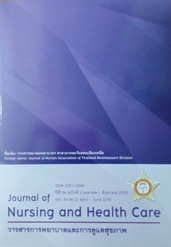การพัฒนาคุณภาพชีวิตผู้สูงอายุตามแนวทางเศรษฐกิจพอเพียง และการมีส่วนร่วมของชุมชน จังหวัดปทุมธานี Development of Quality of Life among the Elderly Utilizing The Concept of Sufficiency Economy and Community Participation, Pathum Thani Province, Thailand
คำสำคัญ:
เศรษฐกิจพอเพียง คุณภาพชีวิต ผู้สูงอายุ การมีส่วนร่วม ชุมชน sufficiency economy, quality of life, elderly, participation, communityบทคัดย่อ
วัตถุประสงค์การวิจัยครั้งนี้ เพื่อพัฒนาคุณภาพชีวิตผู้สูงอายุ ตามแนวทางเศรษฐกิจพอเพียงและการมีส่วน
ร่วมของชุมชน วัสดุและวิธีการเป็นการวิจัยเชิงปฏิบัติการแบบมีส่วนร่วม เลือกตำบลเชียงรากใหญ่ อำเภอสามโคก
และ ตำบลนพรัตน์ อำเภอหนองเสือ จังหวัดปทุมธานี กระบวนการวิจัย 5 ขั้นตอนถูกนำไปใช้โดยการมีส่วนร่วม
ของผู้ที่มีส่วนเกี่ยวข้องในทุกขั้นตอน ดำเนินการในปี 2554-2556 ผลการศึกษา พบว่า เกิดเครือข่ายครอบครัว 2
เครือข่าย มี 17 ครอบครัวที่ร่วมกิจกรรม การเพาะปลูกพืชผักสวนครัวแบบปลอดสารเคมี การปลูกไม้ดอก ไม้ประดับ
เพื่อจำหนา่ ย การเพาะเห็ดเพื่อบริโภคในครัวเรือน และการผลิตผลิตภัณฑบ์ างอยา่ งในรูปแบบการรวมกลุม่ และแบง่
กันใช้ เช่น นํ้ายาล้างจาน นํ้าหมักชีวภาพ สารไล่แมลงจากสมุนไพร กิจกรรมเป็นการประยุกต์ใช้หลักเศรษฐกิจ
พอเพียง 3 ห่วง 2 เงื่อนไข ที่สามารถนำไปใช้ได้จริง ในชีวิตประจำวัน การประหยัดลดค่าใช้จ่าย การแลกเปลี่ยน
เรียนรูจ้ ากภูมิปญั ญาทอ้ งถิ่น สรา้ งความตระหนักตอ่ การใชแ้ หลง่ ประโยชนใ์ นชุมชน การสรา้ งเสริมพลัง การใหข้ อ้ มูลย้อนกลับ และเน้นการมีส่วนร่วม ทำให้เกิดการพัฒนาคุณภาพชีวิตทั้งด้านร่างกาย จิตใจ สังคมและสิ่งแวดล้อม
ข้อเสนอแนะคือ หนว่ ยงานที่เกี่ยวขอ้ งควรรว่ มกันกำหนดนโยบายในการพัฒนาคุณภาพชีวิตผูสู้งอายุอยา่ งเปน็ รูปธรรมโดยการใช้แนวทางเศรษฐกิจพอเพียง แกนนำชุมชนควรร่วมกันดำเนินงานต่อไปและหาทางขยายเครือข่ายเพิ่มขึ้น
Objective: To develop quality of life among the elderly utilizing the concept of sufficiency economy and community participation. Materials and Methods: Participatory action research has been carried out in two settings; 1) Chiangragyai Tambon, Samkog District and 2) Noparat Tambon, Nongsue District,Patum tani Province Thailand. A five-step process of the research has been applied with active participation from stakeholders during 2011-2013.
Results: Two family networks have been developed and 17 families involved in varieties of activities such as growing non-chemical vegetables, flowers, garden trees and mushroom. Some liquid items in houses have been produced. The participants accepted and applied sufficiency economy concept into the daily living. The three loops and two knots as a foundation of sufficiency economy were practical and the benefits from these practices were crucial. Empowerment, feedback and participation process developed the quality of life among the participants in all aspects including physical, mental, social and environmental
dimensions.Suggestions: Relevant organizations and stakeholders should work collaboratively in developing health policy for the elderly by using sufficiency economy concept. Local leaders should continuously carry out the activities and the networks derived from this research should be supported and expanded.



